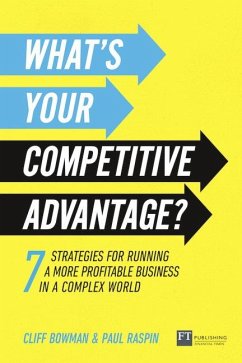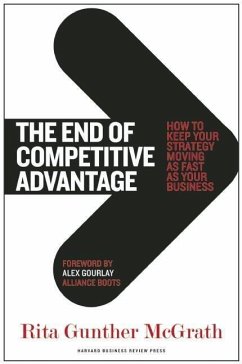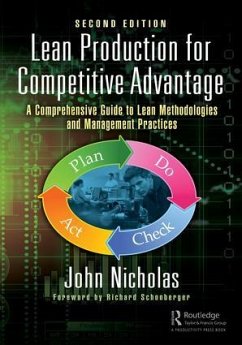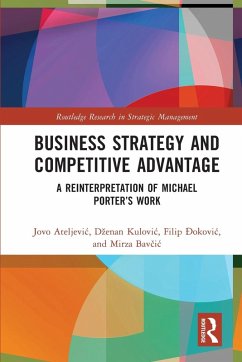
Gaining and Sustaining Competitive Advantage
Pearson New International Edition
Versandkostenfrei!
Versandfertig in 2-4 Wochen
123,99 €
inkl. MwSt.

PAYBACK Punkte
62 °P sammeln!
For courses in Graduate Strategic Management.
Explore the most up-to-date research in the field of strategic management.
Gaining and Sustaining Competitive Advantage provides students and practitioners with the most up-to-date research in a way that helps them see how the concepts can be applied to the real business world. Barney explores the impact of the recent global business changes in relation to the competitive context of firms and their ability to generate and sustain competitive advantages.
The fourth edition has been thoroughly updated to include the latest research in the field.
Features + Benefits
For courses in Graduate Strategic Management.
Explore the most up-to-date research in the field of strategic management.
Gaining and Sustaining Competitive Advantage provides students and practitioners with the most up-to-date research in a way that helps them see how the concepts can be applied to the real business world. Barney explores the impact of the recent global business changes in relation to the competitive context of firms and their ability to generate and sustain competitive advantages.
The fourth edition has been thoroughly updated to include the latest research in the field.
Updated! Stay on the cutting-edge of information: Updated Examples. This text is full of examples from Fortune, BusinessWeek, and the Wall Street Journal, most of which have been updated or changed entirely in the fourth edition. Examples include:
The example in Chapter 1 that discusses Anheuser-Busch’s classic mission statement has been updated to reflect this firm’s new ownership structure and global objectives.
Chapter 5 uses resource-based logic to describe Google’s overwhelming success in recent years, and also uses this same logic to analyze whether or not Google’s level of performance is likely to last.
Provide an accessible approach: An Organized Framework to Integrating Strategic Management Research. The first chapters of this text develop a framework (summarized in Chapter 5) that is used as an organizing script for the rest of the chapters. Within this framework, each of the chapters focus on the specific strategic options that firms choose in order to gain competitive advantage—rather than base the information on the different types of competitive environments firms may face.
Put it all together: Strategy Formulation and Implementation, Combined. In order to effectively evaluate the quality of a firm’s strategy formulation, it’s also vital to analyze the specific strategy that the firm is trying to implement. To help, starting in Chapter 6, this text thoroughly analyzes the strategy in question, which is then followed by an outline of the actions a firm must take in order to implement the strategy effectively.
Capture interest: Enduring Accessibility. The material presented in this text was carefully selected to help spark students’ natural curiosity and provide them with a basis to apply the concepts to. The examples, in particular, come from Fortune, BusinessWeek or the Wall Street Journal to give students a taste of what’s going on in popular business literature.
Highlight what matters: Chapter Summary and Review Questions. Students often have a difficult time pinpointing the most important elements of the reading. The end-of-chapter summaries in this text highlight the key issues discussed in the chapter, while the review questions encourage readers to go beyond understanding the concepts and see the implications involved in managing real firms.
1. Introduction: What Is Strategy?
Jay B. Barney 1
2. Firm Performance and Competitive Advantage
Jay B. Barney 15
3. Evaluating Environmental Threats
Jay B. Barney 45
4. Evaluating Environmental Opportunities
Jay B. Barney 79
5. Evaluating Firm Strengths and Weaknesses: The Resource-Based View
Jay B. Barney 119
6. Product Differentiation
Jay B. Barney 157
7. Cost Leadership
Jay B. Barney 195
8. Flexibility: Real Options Analysis Under Risk and Uncertainty
Jay B. Barney 225
9. Tacit Collusion: Cooperation to Reduce Competition
Jay B. Barney 257
10. Vertical Integration Strategies
Jay B. Barney 283
11. Diversification Strategies
Jay B. Barney 313
12. Implementing Corporate Diversification
Jay B. Barney 345
13. Merger and Acquisition Strategies
Jay B. Barney 377
II
14. Strategic Alliances
Jay B. Barney 405
15. International Strategies
Jay B. Barney 433
Bibliography
Jay B. Barney 465
Index 497
Explore the most up-to-date research in the field of strategic management.
Gaining and Sustaining Competitive Advantage provides students and practitioners with the most up-to-date research in a way that helps them see how the concepts can be applied to the real business world. Barney explores the impact of the recent global business changes in relation to the competitive context of firms and their ability to generate and sustain competitive advantages.
The fourth edition has been thoroughly updated to include the latest research in the field.
Features + Benefits
For courses in Graduate Strategic Management.
Explore the most up-to-date research in the field of strategic management.
Gaining and Sustaining Competitive Advantage provides students and practitioners with the most up-to-date research in a way that helps them see how the concepts can be applied to the real business world. Barney explores the impact of the recent global business changes in relation to the competitive context of firms and their ability to generate and sustain competitive advantages.
The fourth edition has been thoroughly updated to include the latest research in the field.
Updated! Stay on the cutting-edge of information: Updated Examples. This text is full of examples from Fortune, BusinessWeek, and the Wall Street Journal, most of which have been updated or changed entirely in the fourth edition. Examples include:
The example in Chapter 1 that discusses Anheuser-Busch’s classic mission statement has been updated to reflect this firm’s new ownership structure and global objectives.
Chapter 5 uses resource-based logic to describe Google’s overwhelming success in recent years, and also uses this same logic to analyze whether or not Google’s level of performance is likely to last.
Provide an accessible approach: An Organized Framework to Integrating Strategic Management Research. The first chapters of this text develop a framework (summarized in Chapter 5) that is used as an organizing script for the rest of the chapters. Within this framework, each of the chapters focus on the specific strategic options that firms choose in order to gain competitive advantage—rather than base the information on the different types of competitive environments firms may face.
Put it all together: Strategy Formulation and Implementation, Combined. In order to effectively evaluate the quality of a firm’s strategy formulation, it’s also vital to analyze the specific strategy that the firm is trying to implement. To help, starting in Chapter 6, this text thoroughly analyzes the strategy in question, which is then followed by an outline of the actions a firm must take in order to implement the strategy effectively.
Capture interest: Enduring Accessibility. The material presented in this text was carefully selected to help spark students’ natural curiosity and provide them with a basis to apply the concepts to. The examples, in particular, come from Fortune, BusinessWeek or the Wall Street Journal to give students a taste of what’s going on in popular business literature.
Highlight what matters: Chapter Summary and Review Questions. Students often have a difficult time pinpointing the most important elements of the reading. The end-of-chapter summaries in this text highlight the key issues discussed in the chapter, while the review questions encourage readers to go beyond understanding the concepts and see the implications involved in managing real firms.
1. Introduction: What Is Strategy?
Jay B. Barney 1
2. Firm Performance and Competitive Advantage
Jay B. Barney 15
3. Evaluating Environmental Threats
Jay B. Barney 45
4. Evaluating Environmental Opportunities
Jay B. Barney 79
5. Evaluating Firm Strengths and Weaknesses: The Resource-Based View
Jay B. Barney 119
6. Product Differentiation
Jay B. Barney 157
7. Cost Leadership
Jay B. Barney 195
8. Flexibility: Real Options Analysis Under Risk and Uncertainty
Jay B. Barney 225
9. Tacit Collusion: Cooperation to Reduce Competition
Jay B. Barney 257
10. Vertical Integration Strategies
Jay B. Barney 283
11. Diversification Strategies
Jay B. Barney 313
12. Implementing Corporate Diversification
Jay B. Barney 345
13. Merger and Acquisition Strategies
Jay B. Barney 377
II
14. Strategic Alliances
Jay B. Barney 405
15. International Strategies
Jay B. Barney 433
Bibliography
Jay B. Barney 465
Index 497
For courses in Graduate Strategic Management. Explore the most up-to-date research in the field of strategic management. Gaining and Sustaining Competitive Advantage provides students and practitioners with the most up-to-date research in a way that helps them see how the concepts can be applied to the real business world. Barney explores the impact of the recent global business changes in relation to the competitive context of firms and their ability to generate and sustain competitive advantages. The fourth edition has been thoroughly updated to include the latest research in the field.
Dieser Artikel kann nur an eine deutsche Lieferadresse ausgeliefert werden.












